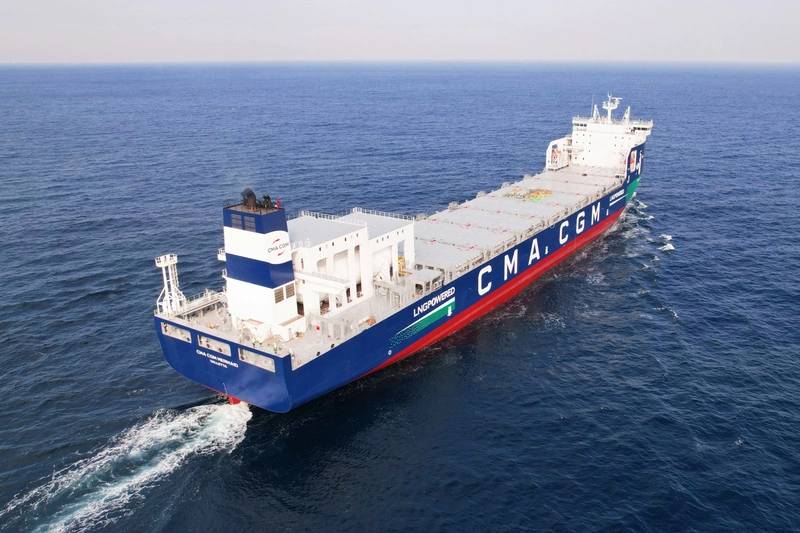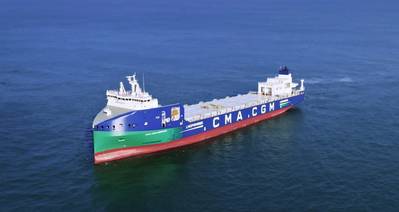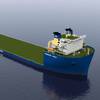CMA CGM Takes Delivery of LNG-Powered Mermaid Containership
French container shipping group CMA CGM has taken delivery of the CMA CGM Mermaid, the first ship in a series of 10 new 2,000 TEU containerships powered by liquefied natural gas (LNG), which will be progressively deployed in the Mediterranean and Northern Europe.
CMA CGM Mermaid containership is the result of collaboration between CMA CGM, Chantiers de l'Atlantique, and Hyundai Heavy Industries.
The delivery is part of CMA CGM's fleet renewal program, in which the group invested more than $15 billion, marking a step closer to meeting its objective of net zero carbon by 2050.
These new containerships, with an original design aimed at improving their energy efficiency and environmental performance, will join the CMA CGM fleet of around 620 vessels, including more than 30 already powered by alternative energies.
The ships will emit up to 20% less CO2 compared to a similar-sized ship with a conventional maritime fuel design (very low sulfur oil), according to the French shipping group.
The CMA CGM MERMAID is set to embark on its voyage to Northern Europe from Busan in South Korea.
Proportions and Technologies Adapted for Better Energy Performance
Determined to optimize energy efficiency in all its activities, CMA CGM decided to resize this new series of ships. One of the original characteristics of the design is the ratio of 204.29 m long to 29.6 m wide to improve the ships’ hydrodynamic and aerodynamic performance.
They are also the first ships in the CMA CGM fleet with superstructures at the front. Thus, placed at the front, the bridge and accommodations ensure better aerodynamic performance and higher loading capacity compared to a conventional architecture.
A new, almost inverted straight bow with an integrated bow bulb also offers better hydrodynamic performance to reduce fuel consumption by 15% per trip, according to the company.
On-Board Energy Mix to Reduce Carbon Footprint
 CMA CGM Mermaid containership (Credit: CMA CGM)These ships are powered by LNG, a lower-carbon energy source than conventional fuel, which reduces sulfur oxide emissions by 99%, nitrogen oxide emissions by 92%, and fine particles by 91%. When cooled to -161°C, LNG powers a 12-megawatt MAN engine. These dual-fuel ships can also carry biogas (-67% eq. CO2) produced from bio-waste and are convertible to e-methane (-85% eq. CO2) produced from decarbonized hydrogen.
CMA CGM Mermaid containership (Credit: CMA CGM)These ships are powered by LNG, a lower-carbon energy source than conventional fuel, which reduces sulfur oxide emissions by 99%, nitrogen oxide emissions by 92%, and fine particles by 91%. When cooled to -161°C, LNG powers a 12-megawatt MAN engine. These dual-fuel ships can also carry biogas (-67% eq. CO2) produced from bio-waste and are convertible to e-methane (-85% eq. CO2) produced from decarbonized hydrogen.
The 10 new containerships will also be equipped with an alternator coupled to the main propulsion engine, which will provide the energy needed to power the onboard electrical installations once at sea.
The latest outstanding innovation in this new generation of containerships is one of the most powerful fuel cells aboard a ship. It is on track to be mounted on the last of the series which is scheduled for delivery in January 2025. As the fuel cell is powered by hydrogen with an energy capacity of 1 MW, this ship will have zero emissions when berthed.
New Range of Feeders for Service in Northern Europe and Intra-Mediterranean
Delivered progressively between February 2024 and January 2025, the ten new vessels will transport goods over short distances, mainly in Northern Europe and the Mediterranean.
Between April and July, six of the series will join the Intra-Northern-Europe line to serve the Baltic and Scandinavian ports from the hubs of Hamburg and Bremerhaven. Four other ships will join the Intra-Mediterranean line between the end of September and the end of November.
Capable of carrying 45’ containers which can be loaded on trailers, these ships offer a more energy-efficient alternative to road transport in Europe and the Mediterranean region.













